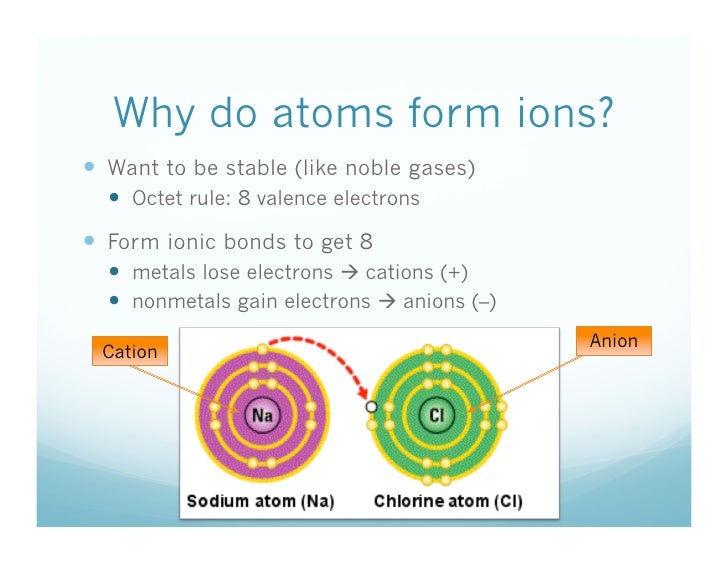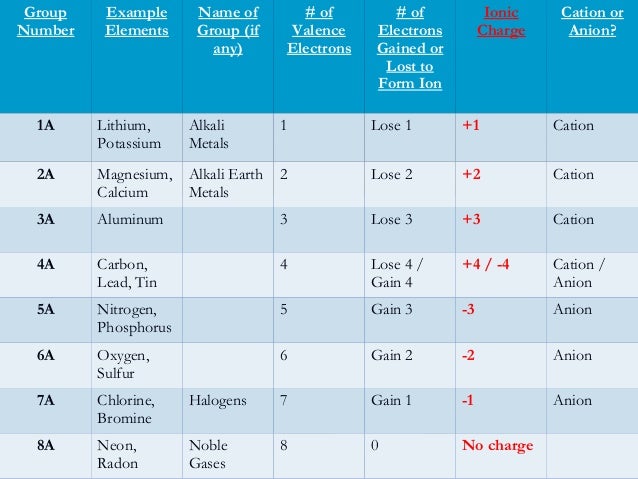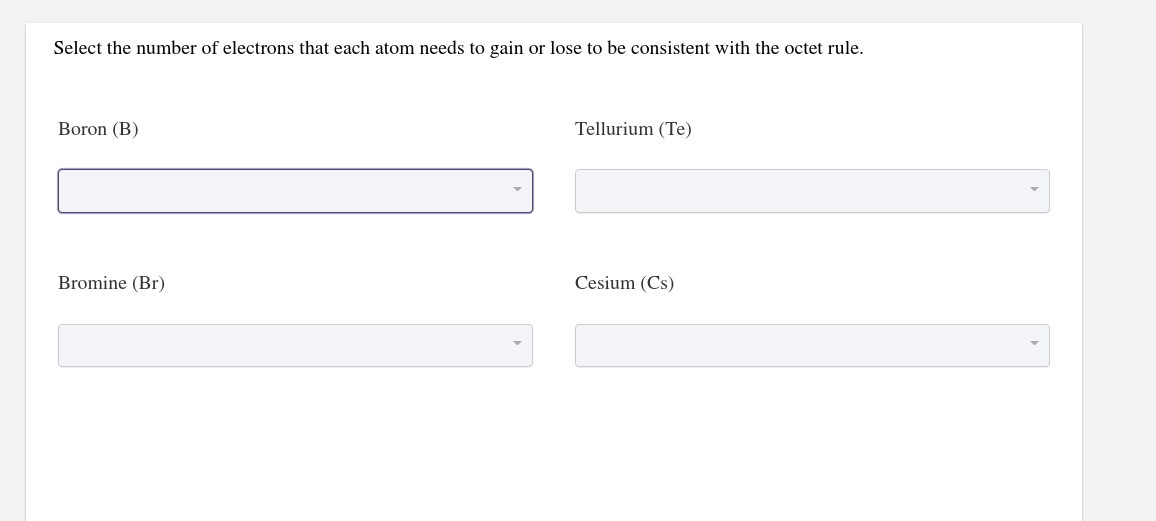Br Lose Or Gain Electrons
Does Br Lose Or Gain Electrons
Name: Per: Ions Worksheet Element # Valence Electrons # Electrons to gain # Electrons to lose Ion Formed/ name Li N O Ca Br S Cl K Mg Be 1 5 None 3 1 None Li +1 / cation N – 3 / anion Questions: 1. If Li loses an electron to another atom, why does it have a have a +1 charge? Elements that are metals tend to lose electrons and become positively charged ions called cations. Elements that are nonmetals tend to gain electrons and become negatively charged ions called anions. Select the number of electrons each atom needs to gain or lose to be consistent with the octet rule. Calcium (Ca) Bromine (Br) lose 2 electrons gain 2 electrons Nitrogen (N) Krypton (Kr) lose 2 electrons.
Click to see full answer
Keeping this in consideration, does bromine lose or gain electrons?
Bromine atoms tend to gain just one electron to get to a full octet, as Bromine is in Group VII. A chemical consisting of an aluminum ion and a bromide ion in their stable states would be AlBr2+, but it is not an ionic compound because it has a charge. Thus it tends to lose two electrons.
Also, how many electrons are gained or lost in iodine? Moving from neutral to +3 charge means it just lost 3 electrons. (Electrons have negative charge.) Similarily, 6 iodine atoms go from -1 to 0, thus gaining one electron.
Hereof, what is the number of electrons gained or lost in chlorine?
It is now referred to as a sodium ion. Chlorine (Cl) in its lowest energy state (called the ground state) has seven electrons in its outer shell. Again, it is more energy-efficient for chlorine to gain one electron than to lose seven.

What is an atom that gains or loses one or more electrons?

An atom that gains one or more electrons will have a NEGATIVE charge. An atom that loses one or more electrons will have a POSTIVE charge. An atom that gains or loses one or more electrons is called an ION. A positive ion is called a CATION and a negative ion is called an ANION.
Most atoms do not have eight electrons in their valence electron shell. Some atoms have only a few electrons in their outer shell, while some atoms lack only one or two electrons to have an octet. In cases where an atom has three or fewer valence electrons, the atom may lose those valence electrons quite easily until what remains is a lower shell that contains an octet. Atoms that lose electrons acquire a positive charge as a result because they are left with fewer negatively charged electrons to balance the positive charges of the protons in the nucleus. Positively charged ions are called cations. Most metals become cations when they make ionic compounds.
Cations

A neutral sodium atom is likely to achieve an octet in its outermost shell by losing its one valence electron.
[ce{Na rightarrow Na^{+} + e^{-}}]
The cation produced in this way, Na+, is called the sodium ion to distinguish it from the element. The outermost shell of the sodium ion is the second electron shell, which has eight electrons in it. The octet rule has been satisfied. Figure (PageIndex{1}) is a graphical depiction of this process.
Anions
Some atoms have nearly eight electrons in their valence shell and can gain additional valence electrons until they have an octet. When these atoms gain electrons, they acquire a negative charge because they now possess more electrons than protons. Negatively charged ions are called anions. Most nonmetals become anions when they make ionic compounds.
A neutral chlorine atom has seven electrons in its outermost shell. Only one more electron is needed to achieve an octet in chlorine’s valence shell. (In table salt, this electron comes from the sodium atom.)

[ce{e^{-} +Cl -> Cl^{-}}]
In this case, the ion has the same outermost shell as the original atom, but now that shell has eight electrons in it. Once again, the octet rule has been satisfied. The resulting anion, Cl−, is called the chloride ion; note the slight change in the suffix (-ide instead of -ine) to create the name of this anion. Figure (PageIndex{2}) is a graphical depiction of this process.
The names for positive and negative ions are pronounced CAT-eye-ons and ANN-eye-ons, respectively.
In many cases, elements that belong to the same group (vertical column) on the periodic table form ions with the same charge because they have the same number of valence electrons. Thus, the periodic table becomes a tool for remembering the charges on many ions. For example, all ions made from alkali metals, the first column on the periodic table, have a 1+ charge. Ions made from alkaline earth metals, the second group on the periodic table, have a 2+ charge. On the other side of the periodic table, the next-to-last column, the halogens, form ions having a 1− charge. Figure (PageIndex{3}) shows how the charge on many ions can be predicted by the location of an element on the periodic table. Note the convention of first writing the number and then the sign on a ion with multiple charges. The barium cation is written Ba2+, not Ba+2.
Contributions & Attributions
Would Be Gain Or Lose Electrons
This page was constructed from content via the following contributor(s) and edited (topically or extensively) by the LibreTexts development team to meet platform style, presentation, and quality:
Marisa Alviar-Agnew (Sacramento City College)
Henry Agnew (UC Davis)